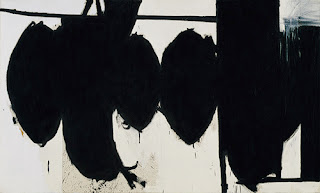We shouldn't underestimate the significance of Joan Miro, currently on show at Tate Modern, 'Joan Miro: The Ladder of Escape'. We can see the 20th Century unfold through his work, about 150 works on show, from early Fauvist pieces, through Cubism and into Surrealism. By the 1960's he was responding to the developments in abstraction taking place in both Europe and America. I wonder if we'd have CoBrA, Dubuffet, Tapies, the playfulness of Arte Povera and many other movements that have the same 'naivety' yet retain a strong political presence, if not for the likes of Miro. This work entitled 'Fireworks, I,II,II' is a great triptych about space and spontaneity, from a man in his eighties with fire in his belly.
 | |
| Joan Miro 'Fireworks, I,II,III' oil on canvas, 1974 (c) Artobserved |
Parallels to Robert Motherwell and especially his 'Elegy to the Spanish Republic' as well as his 'Zen' lithographs abound here, they almost echo each other across the Atlantic. Many of the critics in the British press have focused on the early Miro works as the most significant, but I think the curators (see BBC interview with Matthew Gale here and Marko Daniel) have done well in bringing a sympathetic understanding to the late works, showing his experimental and versatile approach to his art-making in the last few rooms of the exhibition.
 |
| Robert Motherwell 'Elegy to the Spanish Republic' oil on canvas, 1961. (c) Metropolitan Museum |
Most poignant was the last painting in Room 13, entitled 'Tete' (Head) (I unfortunately can't find an image for it). It was a painting started in the 1940's and finished in 1974. It is a black, dark mass with one red beady eye in the centre and a hand in the top left, is it waving or drowning? It has a subtle power suggesting imprisonment, it reminds me of Paul Klee's 'Captive' or 'Embrace' from 1939, that echo a different oppressive era. This is where the strength of Miro lies, in his emotional and political sensibilities with paint as his tool.
 | |||
| Paul Klee 'Embrace' oil on paper, 1939 |
Downstairs we passed through the Turbine Hall and saw what remains of Ai Weiwei's 'Sunflower Seeds' being demounted and bagged up. There were signs reminding the public of his subsequent arrest and I thought how apt that last Miro painting of show was, but also how powerful abstraction in painting can be in such difficult times.
 | ||
| Ai Weiwei's bagged up 'Sunflower seeds', Turbine Hall, Tate Modern (c) David Moxon |
5 comments:
Hi David ,great post
David,
Thank you for this wonderful informative post and sharing your thoughts as well. very useful.
This one, you mean?
http://tinyurl.com/mirosblackhead
Yes that's the one!..strange painting, definately better in the flesh, very compelling and seems so right to end on the painting in the show, regarding the present revolutionary times being experienced..thanks Kodanshi!!
You’re absolutely welcome. I saw that myself and hovered in front of it for quite a while. The one that haunted me the most, however, was the mighty triptych Hope of a Man Condemned to Death. And I will admit to buying a Fireworks tshirt on my way out as well!
Post a Comment